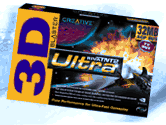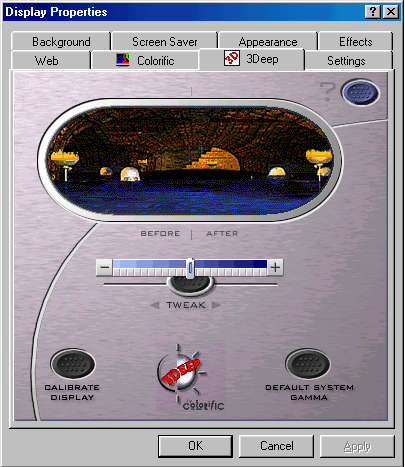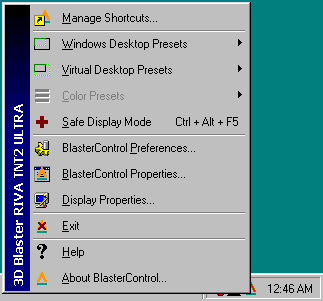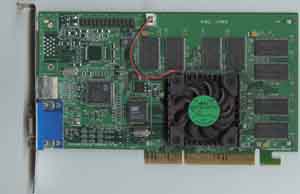
Original Link: https://www.anandtech.com/show/348
 Creative
Labs has long been known for their Sound Blaster line of sound cards. Just about
every sound card released in the past 8 years has touted Sound Blaster compatibility
and even Creative Labs website is www.soundblaster.com.
As the need for Sound Blaster compatibility has faded with Windows providing
a standard sound interface to programs, Creative Labs has begun to turn towards
other markets to sell products in.
Creative
Labs has long been known for their Sound Blaster line of sound cards. Just about
every sound card released in the past 8 years has touted Sound Blaster compatibility
and even Creative Labs website is www.soundblaster.com.
As the need for Sound Blaster compatibility has faded with Windows providing
a standard sound interface to programs, Creative Labs has begun to turn towards
other markets to sell products in.
One such market is the graphics card market that Creative took by storm with the 3D Blaster Voodoo2. Creative's huge retail presence and advertising budget immediately put them on the graphics card map. After the 3dfx/STB and S3/Diamond mergers, the only major graphics chip maker is NVIDIA, who Creative has turned to for their latest in their 3D Blaster series of graphics cards. The most recent is the 3D Blaster TNT2 Ultra, following Creative's no nonsense product naming strategy in the graphics card market. But with NVIDIA the only major graphics chip player left, there is tons of competition in the TNT2 market. Today, we find out how the Creative Labs TNT2 Ultra offering fares in the face of heavy competition.
Card Specifications
(courtesy Creative
Labs)
Architecture Highlights
- Peak fill rate of 300 million bilinear filtered, multi-textured pixels per second
- Over 9 million triangles per second at peak rates
- 2.9 GB/sec total memory bandwidth
- 100% hardware triangle setup engine
- TwiN-Textel (TNT) dual 32-bit 3D rendering pipeline
- 2 texture mapped, lit pixels per clock cycle
- Single pass multi-texturing support (DirectX®6.X and OpenGL® ICD)
3D Features
- Hardware
triangle setup engine
- 2 texture-mapped,
lit pixels per clock cycle
- Single pass multi-texturing support enables features like bump mapping, reflection mapping, texture modulation, and procedural textures
- Per-pixel perspective correct texture mapping
- Full scene, order independent anti-aliasing
- 32-bit
Z and stencil buffer
2D Features
- Hardware acceleration for all Windows GDI operations
- Fast 32-bit VGA/SVGA support
- Multi-buffering
(up to quad buffering) for smooth animation and video playback
Video Support
- Advanced
support for DirectDraw
- Hardware color space conversion (YUV 4:2:2 and 4:2:0
- Multi-tap
X and Y filtering
Card Specifications
- AGP 2X with sideband support
- Analog VGA output
- TV output with S-Video connector (composite adapter cable included)
- VESA DDC2B compatible
Drivers
- Drivers for Windows 95 and Windows 98 (DirectDraw®, Direct3D, OpenGL)
- Drivers for Windows NT® (DirectDraw and OpenGL)
- VBE 2.0
compliant
Refresh Rates
| No. of Colors | |||
| Refresh Rates (Hz) Resolution |
256 | 64K | 16.7M |
| 640x480 | 60, 70, 72, 75, 85, 100, 120, 140, 144, 150, 170, 200 | 60, 70, 72, 75, 85, 100, 120, 140, 144, 150, 170, 200 | 60, 70, 72, 75, 85, 100, 120, 140, 144, 150, 170, 200 |
| 800x600 | 60, 70, 72, 75, 85, 100, 120, 140, 144, 150, 170, 200 | 60, 70, 72, 75, 85, 100, 120, 140, 144, 150, 170, 200 | 60, 70, 72, 75, 85, 100, 120, 140, 144, 150, 170, 200 |
| 1024x768 | 60, 70, 72, 75, 85, 100, 120, 140, 144, 150, 170 | 60, 70, 72, 75, 85, 100, 120, 140, 144, 150, 170 | 60, 70, 72, 75, 85, 100, 120, 140, 144, 150, 170 |
| 1152x864 | 60, 70, 72, 75, 85, 100, 120, 140, 144, 150 | 60, 70, 72, 75, 85, 100, 120, 140, 144, 150 | 60, 70, 72, 75, 85, 100, 120, 140 |
| 1280x1024 | 60, 70, 72, 75, 85, 100, 120 | 60, 70, 72, 75, 85, 100, 120 | 60, 70, 72, 75, 85, 100 |
| 1600x1200 | 60, 70, 72, 75, 85 | 60, 70, 72, 75, 85 | 60, 70, 72, 75 |
| 1920x1080 | 60, 70, 72, 75, 85 | 60, 70, 72, 75, 85 | 60, 70, 72 |
| 1920x1200 | 60, 70, 72, 75, 85 | 60, 70, 72, 75, 85 | 60, 70 |
Click here to find lowest prices on this product.
The Card
At first glance, the 3D Blaster TNT2 Ultra looks identical to the Hercules Dynamite TNT2 Ultra as they're both built upon the same, somewhat sloppily laid out reference design PCB. AnandTech's review sample featured the same 32MB of 5.5ns Hyundai SDRAM used on the Hercules, allowing it to obtain the same 220MHz memory clock that the Hercules reached. TV-out is provided courtesy of the Brooktree BT869 used by most TNT2 reference designs and does a fairly good job (see our TV-out comparison for complete details).
As the name implies, the 3D Blaster TNT2 Ultra is based on the "Ultra" version of the TNT2 chip, which according to NVIDIA, indicates that the core clock speed and the memory clock speed should be no less than 150MHz and 183MHz respectively. However, NVIDIA has left the exact clock speeds up to the manufacturers and many have chosen to ship at higher than these recommended clock speeds.
Creative Labs has chosen to ship at this default setting of 150/183 with no overclocking options out of the box. Cooled by a decent heatsink/fan combo, albeit affixed with too much heatsink compound, we set out to find the limits of our sample card, which hit 170/220. The core clock of 170 seems about average for an overclocked TNT2 Ultra, but is still lower than the pretested and preset 175MHz of the Guillemot and Hercules TNT2 Ultra cards. In the heat tests of our July 1999 TNT2 Roundup, we found that the Creative Labs was the hottest card tested at the default clock rate, and tied with the Diamond when overclocked. Since the heatsink/fan appears to be a fairly high quality model, we can only attribute the high temperatures to the poor application of heatsink compound where clearly too much was used. It's quite possible that the core may be able to go quite a bit higher and the adventurous user may want to try removing the heatsink and applying the proper amount of thermal compound (the minimum possible), but this would be at your own risk and probably void the warranty.
As for the RAM, the Creative featured the same Hyundai 5.5ns SDRAM featured on the Hercules TNT2 Ultra. The memory is organized as eight 2MB chips, all on the front of the board. On both cards, we were able to hit RAM speeds of 220MHz with complete stability. As always, RAM suppliers will probably vary for Creative Labs, but 5.5ns should always be included. As always with overclocking, results will vary from card to card.
The 2D image quality of the Creative Labs TNT2 Ultra is fine at resolutions up to 1280 x 1024, unfortunately at 1600 x 1200 the image quality takes a noticeable dive. Although it is noticeably better than the best TNT cards in terms of 2D image quality, the Dynamite TNT2, as well as most TNT2 based cards, aren't too friendly on your eyes at 1600 x 1200 and above. If you're really looking for a combination of a professional/gaming card then Matrox's G400/G400MAX is probably what you should be setting your sights on, unfortunately getting one of those hot items is easier said than done.
Click here to find lowest prices on this product.
Drivers
By far one of the most unique things about Creative Labs video cards has been the drivers as Creative has constantly come up with unique twists on reference drivers that add some real functionality. Most recently, it has been the release of their Unified Driver package that emulates Glide over Direct3D for compatibility with some older titles that are Glide only. This driver is available for download from Creative's website for all Creative TNT, TNT2, and TNT2 Ultra users.
As far as the drivers included in the 3D Blaster TNT2 Ultra package, they include a custom Creative Labs control panel, called BlasterControl and that offers all kinds of tweaking options, including the MS WHQL banned vsync toggle. Colorific color matching software allows you to match on screen colors to printed output and 3Deep gamma correction software allows for precision gamma control. All this is accessible from a tray icon under Windows 9x or NT. That makes Creative one of the few companies offering NT graphics utilities.
An overclocking utility is not included, but is available for download.
Creative Labs 3D Graphics Blaster TNT2 Ultra - Driver Pictures




Click here to find lowest prices on this product.
Creative Labs 3D Graphics Blaster TNT2 Ultra - Driver Pictures (continued)






Click here to find lowest prices on this product.
Performance
The performance of the Creative Labs 3D Blaster TNT2 Ultra is virtually identical to that of other TNT2 cards out there running at the same clock speed. So instead of publishing the same benchmarks over again, we encourage you to check out the Dynamite TNT2 Ultra Review, our original NVIDIA RIVA TNT2 Review, and the latest July 1999 TNT2 Roundup. Just remember that the 3D Blaster TNT2 Ultra is clocked at the NVIDIA recommended default of 150/183 and AnandTech's sample was able to hit 170/220.
Final Words
The Creative Labs card is your run of the mill retail board, it is available at virtually every corner hardware store and carries the Creative Labs name and reliability. Creative's unique drivers that actually support NT are a big plus for NT users and it's one of the faster, but not the fastest, TNT2 Ultra's available. At $229.99, it's the same price as the Hercules TNT2 Ultra, which comes out of the box at 175/200MHz core/memory clock. Unfortunately, the Hercules isn't the easiest card to find right now, but the Creative Labs is everywhere. Throw in the availability of Creative's Unified Drivers for Glide compatibility and the 3D Blaster TNT2 Ultra is a pretty decent choice in the TNT2 Ultra market.








